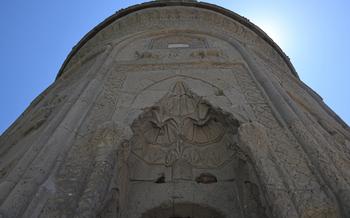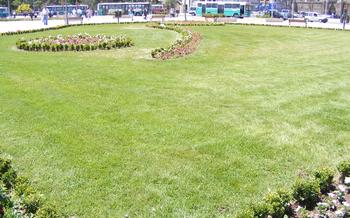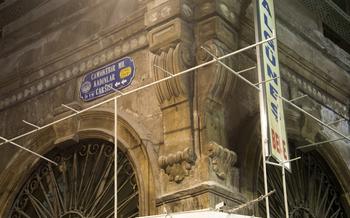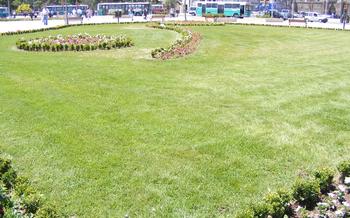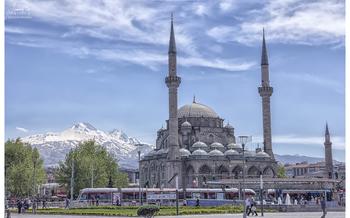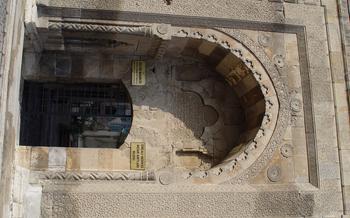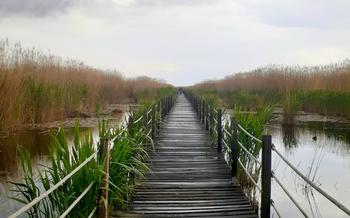
Hunat Hatun Türbesi
- Hunat Hatun Türbesi: A Hidden Gem in Kayseri
- Operating Hours and Tips for Visiting
- Historical Context: The Seljuk Dynasty
- The Türbe's Interior
- Symbolism and Iconography
- The Hunat Hatun Türbesi in Modern Times
- Nearby Attractions in Kayseri
- Hunat Hatun Türbesi in Literature and Art
- Visiting Etiquette and Tips
- Local Traditions and Festivals
- Suggested Itineraries for Kayseri
- Insider Tip: Hidden Gems Nearby
Hunat Hatun Türbesi: A Hidden Gem in Kayseri
Nestled in the heart of Kayseri, a city steeped in history and architectural marvels, lies a hidden gem waiting to be discovered: the Hunat Hatun Türbesi. This breathtaking mausoleum, commissioned by Sultan Alaeddin Keykubad I in the 13th century, stands as a testament to the Seljuk dynasty's legacy and the remarkable craftsmanship of its artisans.
Located just a short walk from the city center, the Hunat Hatun Türbesi is an oasis of tranquility amidst the bustling streets of Kayseri. Its serene ambiance invites visitors to step back in time and immerse themselves in the grandeur of Seljuk architecture. The türbe is typically open to the public during daylight hours, with no admission fee required, making it an accessible destination for history enthusiasts and travelers seeking cultural experiences.
To capture the essence of this architectural masterpiece, it is advisable to visit during the golden hours of sunrise or sunset. As the warm hues of the sun caress the türbe's intricate carvings, the shadows cast by its octagonal structure create a mesmerizing play of light and form. Whether you're a seasoned traveler or a first-time visitor to Kayseri, the Hunat Hatun Türbesi promises an unforgettable encounter with history, art, and spirituality.
Operating Hours and Tips for Visiting
The Hunat Hatun Türbesi stands open to visitors every day of the week, offering free admission. Whether you choose to visit during the bustling daytime hours or prefer the serenity of the early morning or late afternoon, the türbe provides an immersive experience regardless of the time.
For those seeking a tranquil atmosphere, avoiding the peak tourist hours is advisable. The türbe's less crowded periods allow for a deeper connection with the site's history and spiritual significance. However, if you favor capturing the vibrant essence of a bustling pilgrimage site, visiting during prayer times or special occasions may be a rewarding choice.
Remember to dress respectfully, covering your shoulders and knees, as a sign of reverence for the religious nature of the site. By observing local customs and traditions, you'll enhance your experience and show respect to the cultural heritage of Turkey.
Historical Context: The Seljuk Dynasty
The Hunat Hatun Türbesi stands as a testament to the rich history and cultural heritage of the Seljuk Empire, which played a pivotal role in shaping the political and cultural landscape of Anatolia.
The Seljuks, an Oghuz Turkic dynasty, emerged in the late 10th century and established a vast empire that stretched from Central Asia to the Mediterranean Sea. In the 11th century, they conquered Anatolia, a region that had been under Byzantine rule for centuries.
The Seljuk Sultanate of Rum, established in Anatolia, became a powerful and influential state that ruled over the region for nearly two centuries. Kayseri served as one of the sultanate's important centers and was home to a thriving Seljuk community.
The Seljuks were renowned for their architectural achievements, and the Hunat Hatun Türbesi is a prime example of their mastery in this field. The türbe's unique octagonal design and intricate carvings reflect the Seljuk's commitment to artistic excellence and their desire to create enduring monuments that would symbolize their power and prestige.
The Türbe's Interior
Step inside the Hunat Hatun Türbesi, and you'll find yourself in an atmosphere of serenity and reverence. The türbe's interior is relatively simple, but its beauty lies in its details. The walls are adorned with intricate carvings and decorative elements, each telling a unique story. Look up, and you'll see a magnificent dome that seems to float effortlessly above you.
The türbe's centerpiece is the cenotaph, a symbolic tomb that represents Hunat Hatun's final resting place. The cenotaph is intricately carved with geometric patterns and verses from the Quran. Its beauty is a testament to the skill and artistry of the Seljuk craftsmen.
As you explore the türbe's interior, take a moment to appreciate the atmosphere and ambiance. The soft light filtering through the windows creates a sense of peace and tranquility. The air is filled with the scent of incense, adding to the sacredness of the space.
For photography enthusiasts, the Hunat Hatun Türbesi offers a wealth of opportunities. The türbe's intricate carvings and decorative elements make for stunning photographs. To capture the best angles, position yourself in the center of the room and shoot upwards to showcase the dome's grandeur. Remember to use a tripod to ensure sharp and steady shots.
Symbolism and Iconography
The Hunat Hatun Türbesi is a treasure trove of symbolic and iconographic elements that provide insights into the worldview of the Seljuk Turks. The octagonal shape of the türbe holds deep significance, representing the eight gates of paradise in Islamic cosmology. The intricate carvings and decorative motifs adorning the exterior and interior of the türbe are not merely ornamental but carry profound symbolic meanings.
Geometric patterns, such as stars and octagons, are prevalent throughout the türbe's design, symbolizing the order and harmony of the universe. Calligraphic inscriptions in Arabic script adorn the türbe's walls, featuring verses from the Quran and poetic tributes to Hunat Hatun. These inscriptions serve as reminders of the spiritual and religious significance of the site.
The türbe's dome, with its elegant curves and intricate patterns, is a testament to Seljuk architectural prowess and their mastery of construction techniques. The dome symbolizes the heavens and the divine realm, representing the aspiration of the deceased to reach a higher spiritual plane.
The Hunat Hatun Türbesi, with its rich symbolism and iconography, stands as a testament to the cultural and artistic achievements of the Seljuk dynasty. It is a place where history, religion, and art converge, inviting visitors to delve into the depths of Seljuk culture and heritage.
The Hunat Hatun Türbesi in Modern Times
The Hunat Hatun Türbesi stands as a proud testament to the Seljuk dynasty's rich legacy. Recognized as a significant historical and cultural landmark, the türbe has garnered immense respect and admiration over the years. To ensure its enduring preservation, meticulous conservation and restoration efforts have been undertaken, safeguarding this architectural masterpiece for future generations.
Today, the Hunat Hatun Türbesi has emerged as a popular tourist destination, drawing visitors from across the globe. Its captivating allure lies not only in its historical significance but also in its exquisite artistry and symbolic representation of Seljuk power. As a testament to its enduring appeal, the türbe has become an iconic symbol of Kayseri, attracting countless travelers eager to delve into the depths of Turkey's rich cultural heritage.
Nearby Attractions in Kayseri
While exploring the Hunat Hatun Türbesi, take the opportunity to immerse yourself in the rich history and culture of Kayseri by visiting other notable landmarks and attractions in the city. Stroll through the bustling streets of the Kayseri Bazaar, where you can haggle for traditional handicrafts, carpets, and souvenirs. Discover the majestic Kayseri Castle, an imposing structure that offers panoramic views of the city. Step into the Koçasinan Madrasah, a beautifully preserved Seljuk-era building that houses an impressive collection of Islamic artifacts. For a glimpse into Kayseri's culinary heritage, savor the delectable flavors of local dishes like mantı (Turkish ravioli) and Kayseri pastırması (air-dried beef).
Create a self-guided walking tour to explore these attractions at your own pace. Start at the Hunat Hatun Türbesi and head towards the Kayseri Bazaar, located just a short walk away. From there, make your way to the Koçasinan Madrasah, which is situated in the heart of the city. End your tour at Kayseri Castle, which is perched on a hill overlooking the city. Alternatively, join a guided tour to delve deeper into the history and significance of these landmarks.
For a comprehensive cultural experience, combine your visit to the Hunat Hatun Türbesi with other activities that Kayseri has to offer. Attend a traditional Turkish music concert or a whirling dervish performance to immerse yourself in the vibrant local culture. Take a cooking class to learn the secrets of Turkish cuisine and recreate your favorite dishes back home. Venture beyond the city center to explore the surrounding natural wonders, such as the Erciyes Mountain, a popular destination for hiking, skiing, and snowboarding enthusiasts.
To make the most of your trip, plan your transportation in advance. Kayseri has a well-connected public transportation system, including buses and trams, that can take you to most of the city's attractions. You can also rent a car for a more flexible and independent way to explore. Remember to check the operating hours and admission fees (if applicable) of each attraction before your visit to avoid any inconvenience.
Hunat Hatun Türbesi in Literature and Art
The Hunat Hatun Türbesi has inspired artists and writers throughout history, leaving its mark on literature and art. In the 17th century, the famous Turkish traveler Evliya Çelebi visited the türbe and described its beauty and grandeur in his travelogue, Seyahatnâme. Centuries later, the renowned Turkish poet Yahya Kemal Beyatlı wrote a poem titled "Hunat Hatun Türbesi," which captured the essence of the türbe and its significance in Seljuk history.
In the realm of visual arts, the türbe has been depicted in numerous paintings and drawings. One notable example is the painting by the Turkish artist Ali Riza Türker, which portrays the türbe's serene and majestic presence against the backdrop of the Kayseri cityscape. The türbe's unique architectural features and intricate carvings have also been a source of inspiration for contemporary artists, who have incorporated elements of its design into their own works.
Beyond its historical and architectural value, the Hunat Hatun Türbesi has become a symbol of love and devotion, inspiring stories and legends that have been passed down through generations. These stories often revolve around the life of Hunat Hatun and her unwavering love for her husband, Sultan Alaeddin Keykubad I.
The Hunat Hatun Türbesi continues to captivate the imagination of visitors from all walks of life. Its enduring legacy as a source of inspiration for artists and writers ensures that its story will live on for many generations to come.
Visiting Etiquette and Tips
When visiting the Hunat Hatun Türbesi, it is important to observe proper etiquette and respect the sanctity of the site. Here are some tips to ensure a respectful and enjoyable visit:
-
Appropriate Dress: Dress modestly and avoid wearing revealing or inappropriate clothing. Both men and women should cover their shoulders and knees.
-
Behavior: Be respectful and maintain a quiet demeanor while inside the türbe. Avoid loud conversations or disruptive behavior that may disturb other visitors or the peaceful atmosphere of the site.
-
Photography: Photography is generally allowed inside the türbe, but it is important to be mindful of other visitors and avoid using flash or disturbing their experience. Ask permission before taking photographs of people, and be respectful of their privacy.
-
Peak Seasons: During peak tourist seasons or special events, the türbe may be crowded. Be prepared for crowds and plan your visit accordingly. If possible, visit during off-peak hours or on weekdays to avoid large groups.
-
Special Events: If you happen to visit during a special event or religious ceremony, be respectful and observe local customs and traditions. Ask questions if you are unsure about any practices or rituals, and avoid disrupting the proceedings.
Local Traditions and Festivals
The Hunat Hatun Türbesi is deeply entwined with local traditions and customs. During special occasions, the türbe becomes the focal point of religious ceremonies and events that honor the memory of Hunat Hatun and her contributions to the Seljuk Empire.
Annual Commemoration: Every year, a special commemoration ceremony is held at the türbe to pay tribute to Hunat Hatun. This ceremony involves religious recitations, prayers, and the distribution of food and blessings to visitors.
Seljuk Heritage Festival: The city of Kayseri also hosts an annual Seljuk Heritage Festival, which celebrates the rich history and legacy of the Seljuk dynasty. During this festival, the Hunat Hatun Türbesi is a central attraction, with guided tours, historical reenactments, and cultural performances taking place in its vicinity.
Prayer and Reflection: For many locals, the Hunat Hatun Türbesi is a place of prayer and reflection. Visitors often come to the türbe to seek blessings, pray for good fortune, or simply find solace and peace amidst its serene surroundings.
To fully immerse yourself in the local traditions and customs associated with the Hunat Hatun Türbesi, it is advisable to engage with the local community and seek out opportunities to learn about their beliefs and practices. Attending local festivals, participating in religious ceremonies, or simply striking up conversations with friendly locals can provide valuable insights into the cultural significance of this remarkable site.
Suggested Itineraries for Kayseri
When planning your trip to Kayseri, consider the following itineraries to make the most of your time:
One-Day Itinerary:
- Start your day with a visit to the Hunat Hatun Türbesi, exploring its unique architecture and historical significance.
- Immerse yourself in the city's Seljuk heritage by visiting the Kayseri Castle, marveling at its fortifications and panoramic views.
- Discover the exquisite collection of artifacts at the Kayseri Archaeological Museum, gaining insights into the region's rich past.
- End your day with a stroll through the vibrant Kayseri Bazaar, experiencing the lively atmosphere and indulging in local delicacies.
Two-Day Itinerary:
- Dedicate your first day to exploring the Hunat Hatun Türbesi and other Seljuk landmarks, including the Gevher Nesibe Türbesi and the Döner Kümbet.
- On your second day, venture beyond the city center to discover hidden gems like the Sivaslı Madrasa and the Ağırnas Türbesi, immersing yourself in the region's architectural wonders.
- Take advantage of Kayseri's culinary scene by savoring traditional dishes at local restaurants or participating in a cooking class to learn the art of Turkish cuisine.
Three-Day Itinerary:
- With three days in Kayseri, you can delve deeper into the city's history and culture.
- Explore the Museum of Seljuk Civilization, showcasing the empire's contributions to art, architecture, and science.
- Embark on a day trip to nearby attractions such as the impressive Uçhisar Castle or the picturesque Ihlara Valley, combining natural beauty with historical exploration.
- Immerse yourself in the vibrant nightlife of Kayseri, enjoying live music, traditional dance performances, and the lively atmosphere of local bars and cafes.
Remember, these itineraries are merely suggestions, and you can tailor them to suit your interests and preferences. Kayseri offers a wealth of experiences, so embrace the flexibility to create a personalized journey that resonates with you.
Insider Tip: Hidden Gems Nearby
Apart from the awe-inspiring Hunat Hatun Türbesi, Kayseri is brimming with hidden gems waiting to be discovered. Venture off the beaten path and explore the city's lesser-known treasures.
Nestled amidst narrow cobbled streets, uncover the hidden courtyard of the Gıyaseddin Keyhüsrev Külliyesi, a 13th-century religious complex boasting intricate tilework and serene ambiance. Immerse yourself in the aromatic world of the Kayseri Spice Market, where vibrant colors and heady fragrances create a sensory feast.
For a glimpse into local life, visit the traditional Turkish bathhouses, or hamams, scattered throughout the city. Indulge in a rejuvenating hammam experience, complete with steamy marble chambers, soothing massages, and invigorating scrubs.
Explore the labyrinthine alleys of the Kayseri Bazaar, a bustling marketplace where you can haggle for unique souvenirs, handmade crafts, and delectable Turkish delights. Be sure to sample the city's renowned pastırma, a cured meat delicacy that has earned Kayseri culinary fame.

